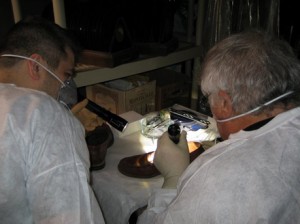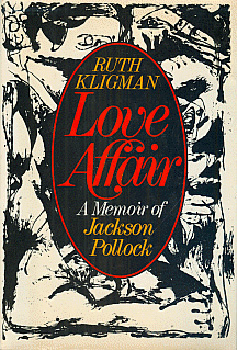Magnifying Fakes
Randee Silv
December 2013
Situation#1: Kligman’s Red, Black & Silver
Situation #2: 123 Frida Kahlo Replicas
Situation #3: Qian/Diaz/Rosales/Knoedler

“Who are the best artists, who should I know, in what order—one, two, and three?” Ruth Kligman asked Audrey Flack. “Jackson Pollock, Bill de Kooning, and Franz Kline.” Flack drew her a map to the Cedar Bar, described Pollock and where he sat.
“The final painting of your life, your legacy to me, silver shimmering substance of the cosmos, the red heart oval shape of love, and the black form grounds the field.” Pollock hadn’t painted in years. Knowing this, Kligman supplied him with a canvas board that already had a few of her strokes on the top left corner. “You quickly got the paint and sticks and I watched dazzled as you created it. How incredible, miraculous you were that afternoon in the sun at the house in Springs, smiling at me.” Lee Krasner, fed up with their affair, had taken off for Europe that summer.
The Pollock-Krasner Authentication Board of course asked, “Why was this quite significant and moving moment in her relationship not reported?” Rumor was that she didn’t want to face her lover’s wife. It hadn’t been mentioned in her 1974 Love Affair: A Memoir of Jackson Pollock, only in the 1999 paperback version.
Frank O’Hara: “Death-car girl.” Bill de Kooning: “She really puts lead in my pencil.” Franz Kline: “Miss Grand Concourse.” Jasper Johns: “She seemed to express a genuine erotic affection for well-known artists.” Lee Krasner: “Pathetic and petty.” Someone: “If she wants a Pollock, she should buy a Pollock.”
“My Five Fucks with Jackson Pollock—because that’s all there were!” That’s the title Krasner thought it should’ve had. Art dealer Eugene Thaw & art historian Francis O’Connor, the editors of the 1978 Pollock catalogue raisonné on Krasner’s request, referred to Kligman’s book as a “fictionalized memoir.” As the executor of Pollock’s estate, Krasner could acknowledge a painting or deem it worthless. She set the terms for the interpretations of his life. Harold Rosenberg had written in Esquire that her marketing strategies “almost single-handedly forced up prices for contemporary American abstract art.”
Kligman hid the small unsigned, 24 x 20″ painting away in her downtown studio, where it remained until her death in 2010. Jasper Johns said he had only seen a photograph of it. I read that Kligman had showed the painting under her name in an 80’s East Village show.
She contacted Christie’s in the 90‘s. Ronald Kosnski said that “the painting was the only thing she had left of any value to save her life; Ruth was living on sardines.” Her husband knew nothing about it. It seems that he did see a large drip painting there, but it had been done by Mike Bildo, appropriation artist. I’d once met a painter who called himself a “Pollockist” that made a living doing knock-offs. Christie’s was more than happy to include Red, Black & Silver in their Contemporary Art auction, valuing it at a possible $500,000 to 1.2 million dollars. That was before they found out that it wasn’t in the catalogue raisonné. Without a certificate of authentication, it would be hard to sell. Kligman’s only option was to try and persuade the board. Red, Black & Silver was submitted in 1992. The board would not commit.
Affidavits and further information addressing the board’s concerns and doubts were submitted almost 2 years later. Leo Castelli wrote that Pollock’s “control of the paint is evident and one can actually feel the rhythm in the painting.” Dore Aston wrote, “I have no reason to doubt the authenticity of this painting which, it seems to me, is utterly characteristic of Pollock.” Bette Waldo Benedict explained that days before the fatal car accident, Kligman had returned to New York City and left her the painting. “Even though it doesn’t look like a Jackson Pollock painting, it is. He did it, and I know that. I kept it in my closet on a shelf, in the dark. I didn’t really want to touch it.” Results from scientific testing confirmed it could have been painted in 1956. The board wasn’t convinced.
Their final decision was to include the painting in the “Unresolved Attributions” section of the upcoming supplement with a color photo and a brief description of Kligman’s story. She rejected the offer. Her executor, Davey Frankel, stated that, “The full recognition of the painting as the last thing he ever painted in his life—that meant more to her than compromising certain things.” Another legal team was hired by Kligman. “My integrity is a very large part of my existence, I am an artist and this is truth.” Details analyzing gestural motions, pigment colors and Kligman’s lie detector results were submitted in 1997. The board had already disbanded after their third lawsuit.
6 of the 24 Pollock contenders (8 had already been sold), found wrapped in brown paper in a storage bin by Herbert and Mercedes Matter’s son Alex, were examined in 2006 by physics professor Richard Taylor on the request of the Pollock-Krasner Foundation. Taylor determined that their fractal makeup was different from the Pollock drip paintings he had already studied. Harvard’s Center for Conservation tested three of these paintings. The orange and brown paint used had not been available yet. Kligman, upon hearing the results, contacted Taylor. He confirmed that the fractal patterns in Red, Black & Silver were a match. Katherine Jones-Smith from Case Western Reserve University challenged Taylor’s findings and compared photoshop doodles of stars and drip paintings from local painters to the Pollock characteristics. They showed the same fractal geometry. Taylor went on to write Fractal Expressionism: The Art and Science of Jackson Pollock.
Still unauthenticated, the painting was considered again for auction. In a 2010 Vanity Fair article that opened up even more unresolved questions, Lesley M.M. Blume wrote that the painting was “a national treasure long denied its proper place in the cultural landscape by an elite art-world clique honoring a personal vendetta against Kligman on behalf of Pollock’s wife, artist Lee Krasner.” The auction was postponed.
O’Connor, in a 2012 lecture, Forensic Connoisseurship, Jackson Pollock and the Authentic Eye, explained that “The art expert has seen hundreds — maybe thousands — of works by the artist in question, and has absorbed into visual memory the artist’s characteristic form — his shapes, compositional devices, linear rhythms, typical colors, and habits of paint manipulation — and with Pollock, fractal cues… This can seem mysterious, if not laughable, to the layperson — whose education is almost always based on verbal or quantitative, not visual, criteria of meaning.”
The Kligman estate went ahead and hired Nicholas Petraco, a former NYC detective and forensics specialist. “He treated it as he would treat a crime scene investigation. Everything was in evidence bags.” witnessed Helen Harris at the Pollock Krasner House & Study Center. Colette Loll, a private fraud investigator, saw this as “a real opportunity to shift the paradigm away from the dictatorship of the connoisseur, where only one or two people who sit on their thrones can decide what is and what is not an authentic painting.” Petraco found nothing under the paint layers to connect it to Ruth Kligman. But he did find a polar bear hair from the rug that was stored in the Pollocks’ attic. According to Petraco, “Trace evidence serves as an unbiased, impartial, silent witness to an event. It has no human prejudices or agenda.”
O’Connor also pointed out that, “The authenticity of a work of art lies in its immediate historicity. There is something almost genetic in such historicity — in our sense of a connection with the past — and especially with an artist such as Pollock — who so generously and transparently shared a creative process with the viewer that cannot be imitated.”
Kligman had no beneficiaries. Maybe they painted it together; or maybe Pollock really did say to Kligman, “Here’s your painting, your very own Pollock.” Another auction date is yet to be set.

N. Petraco, Forensic investigator & J. Kramer, Kligman’s trustee examining Pollock’s shoe, photo: Helen Harrison
Love Affair: A Memoir of Jackson Pollock by Ruth Kligman, 1974 version, photo: Left Coast Books
Ruth Kligman, Broken Cosmos, 1950 7″ X 8″, oil on canvas, photo: artist’s website
Situation #1: Kligman’s Red, Black & Silver
Situation #2: 123 Frida Kahlo Replicas
Situation #3: Qian/Diaz/Rosales/Knoedler

